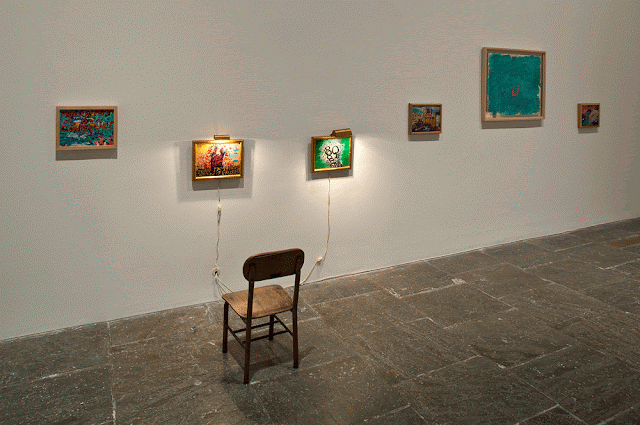Paul Thek (November 2, 1933 - August 10, 1988) was an American painter and, later, sculptor and installation artist Born in Brooklyn, he studied locally, at the Art Students League and Pratt Institute. In 1951 he entered Cooper Union.
Although Thek began as a painter, he became known later in life for his sculptures and installations. Notable works include Technological Reliquaries (1964–67), a series of wax sculptures of human body parts presented on pedestals in glass or acrylic cases, and The Tomb (1967), a bright pink ziggurat installation. The pink ziggurat had a ramp that led to an effigy of the artist inside with a casted replica of Thek's body. Thek realized an alter ego in this piece which began his interest as a performance artist.Unfortunately The Tomb was badly damaged in 1981, however the piece was documented in Edwin Klein's black and white photographs.Today his work may be seen in numerous collections, including that of the Hirshhorn Museum and Sculpture Garden in Washington, D.C. and the Whitney Museum of American Art in New York.
Thek, who was bisexual, died of AIDS related illness in New York City in 1988, aged 54.
In 1954, Thek moved to Miami and worked in several different occupations. He formed a partnership with the set designer Peter Harvey,[6] who would design for Balanchine and who introduced him to artists, composers and writers, among them Tennessee Williams.During this time, he created some of his first well-known drawings, including studies in charcoal and graphite, later followed by abstract watercolors and monochrome oil paintings. Thek first referred to himself as Paul Thek starting in 1955. In 1957 Thek exhibited his works for the first time in a Miami gallery.
During the 1970s, Thek lived in Italy, where he created many works in conjunction with friend and photographer Peter Hujar. In 1976, Thek returned to New York once again. Having lost what prestige he had accumulated in the American art scene of the 1960s, he spent his remaining days washing floors and bagging groceries, however creating art all along. On August 10, 1988, Thek, weakened by HIV/AIDS, died of illness. Susan Sontag dedicated her classic and influential 1966 collection of critical essays, Against Interpretation, which took up with the latest developments in European critical thought—notably that of Roland Barthes—and her later AIDS and its Metaphors to Thek's memory.Wikipedia
Although Thek began as a painter, he became known later in life for his sculptures and installations. Notable works include Technological Reliquaries (1964–67), a series of wax sculptures of human body parts presented on pedestals in glass or acrylic cases, and The Tomb (1967), a bright pink ziggurat installation. The pink ziggurat had a ramp that led to an effigy of the artist inside with a casted replica of Thek's body. Thek realized an alter ego in this piece which began his interest as a performance artist.Unfortunately The Tomb was badly damaged in 1981, however the piece was documented in Edwin Klein's black and white photographs.Today his work may be seen in numerous collections, including that of the Hirshhorn Museum and Sculpture Garden in Washington, D.C. and the Whitney Museum of American Art in New York.
Thek, who was bisexual, died of AIDS related illness in New York City in 1988, aged 54.
In 1954, Thek moved to Miami and worked in several different occupations. He formed a partnership with the set designer Peter Harvey,[6] who would design for Balanchine and who introduced him to artists, composers and writers, among them Tennessee Williams.During this time, he created some of his first well-known drawings, including studies in charcoal and graphite, later followed by abstract watercolors and monochrome oil paintings. Thek first referred to himself as Paul Thek starting in 1955. In 1957 Thek exhibited his works for the first time in a Miami gallery.
During the 1970s, Thek lived in Italy, where he created many works in conjunction with friend and photographer Peter Hujar. In 1976, Thek returned to New York once again. Having lost what prestige he had accumulated in the American art scene of the 1960s, he spent his remaining days washing floors and bagging groceries, however creating art all along. On August 10, 1988, Thek, weakened by HIV/AIDS, died of illness. Susan Sontag dedicated her classic and influential 1966 collection of critical essays, Against Interpretation, which took up with the latest developments in European critical thought—notably that of Roland Barthes—and her later AIDS and its Metaphors to Thek's memory.Wikipedia












No comments:
Post a Comment